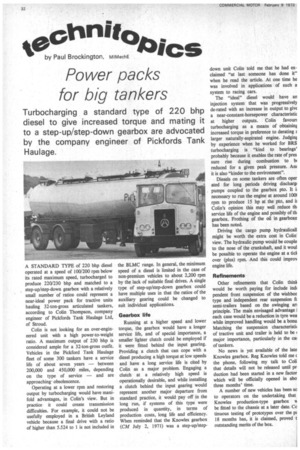Power packs for big tankers
Page 34

If you've noticed an error in this article please click here to report it so we can fix it.
Turbocharging a standard type of 220 bhp diesel to give increased torque and mating it to a step-up/step-down gearbox are advocated by the company engineer of Pickfords Tank Haulage
A STANDARD TYPE of 220 bhp diesel operated at a speed of 100/200 rpm below its rated maximum speed, turbocharged to produce 220/230 bhp and matched to a step-up/step-down gearbox with a relatively small number of ratios could represent a near-ideal power pack for tractive units hauling 32-ton-gross articulated tankers, according to Colin Thompson, company engineer of Pickfords Tank Haulage Ltd, of Stroud.
Colin is not looking for an over-engineered unit with a high power-to-weight ratio. A maximum output of 230 bhp is considered ample for a 32-ton-gross outfit. Vehicles in the Pickford Tank Haulage fleet of some 300 tankers have a service life of about seven years — between 200,000 and 450,000 miles, depending on the type of service — and are approachingobsolescence.
Operating at a lower rpm and restoring output by turbocharging would have manifold advantages, in Colin's view. But in practice it could create transmission difficulties. For example, it could not be usefully employed in a British Leyland vehicle because a final drive with a ratio of higher than 5.524 to 1 is not included in the BLMC range. In general, the minimum speed of a diesel is limited in the case of non-premium vehicles to about 2,200 rpm by the lack of suitable final drives. A single type of step-up/step-down gearbox could have multiple uses in that the ratios of the auxiliary gearing could be changed to Suit individual applications.
Gearbox life
Running at a higher speed and lower torque, the gearbox would have a longer service life, and of special importance, a smaller lighter clutch could be employed if it were fitted behind the input gearing. Providing a clutch that can cope with a diesel producing a high torque at low speeds and have a long service life is cited by Colin as a major problem. Engaging a clutch at a relatively high speed is operationally desirable, and while installing a clutch behind the input gearing would represent another major departure from standard practice, it would pay off in the long run, if systems of this type were produced in quantity, in terms of production costs, long life and efficiency. When reminded that the Knowles gearbox (CM July 2, 1971) was a step-up/step down unit Colin told me that he had exclaimed "at last someone has done it" when he read the article. At one time he was involved in applications of such a system to racing cars.
The "ideal" diesel would have an injection system that was progressively de-rated with an increase in output to givc a near-constant-horsepower characteristic at higher outputs. Colin favour: turbocharging as a means of obtainini increased torque in preference to derating E larger naturally-aspirated engine. Judgini by experience when he worked for BRS turbocharging is "kind to bearings' probably because it enables the rate of pres sure rise during combustion to bt reduced for a given peak pressure. An it is also "kinder to the environment".
Diesels on some tankers are often oper ated for long periods driving discharg pumps coupled to the gearbox pto. It i necessary to run the engine at around 1001 rpm to produce 15 hp at the pto, and ii Colin's opinion this may well reduce th service life of the engine and possibly of th gearbox. Frothing of the oil in gearboxe has been noted.
Driving the cargo pump hydraulicall might be worth the extra cost in Colin view. The hydraulic pump would be couple to the nose of the crankshaft, and it woul be possible to operate the engine at a tick over (plus) rpm. And this could improN engine life.
Refinements
Other refinements that Colin think would be worth paying for include in& pendent front suspension of the wishbor type and independent rear suspension ft semi-trailers based on the swinging an principle. The main envisaged advantage 1 each case would be a reduction in tyre wea while improved handling would be a bonu Matching the suspension characteristii of tractive unit and trailer is held to be major importance, particularly in the Ca: of tankers.
No news is yet available of the late Knowles gearbox. Reg Knowles told me c the phone, following my talk to Coli that details will not be released until pr duction had been started in a new factor which will be officially opened in abo three months' time.
A number of new vehicles has been sc to operators on the undertaking that Knowles production-type gearbox be fitted to the chassis at a later date. Cc tinuous testing of prototypes over the ix 18 months has, it is claimed, proved t outstanding merits of the box.
































































































